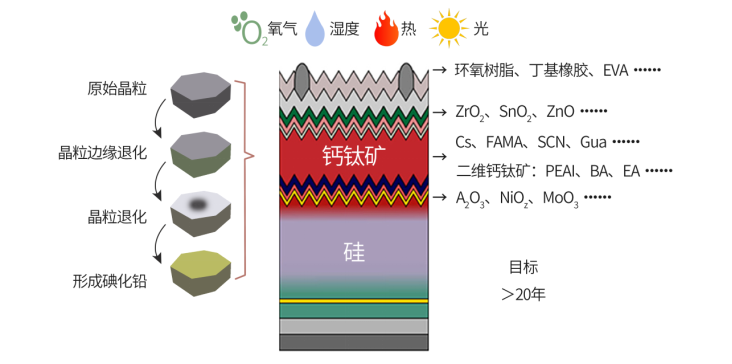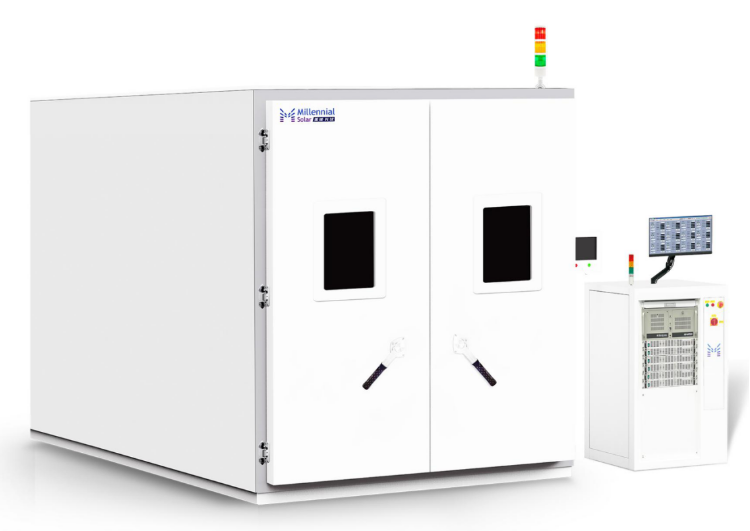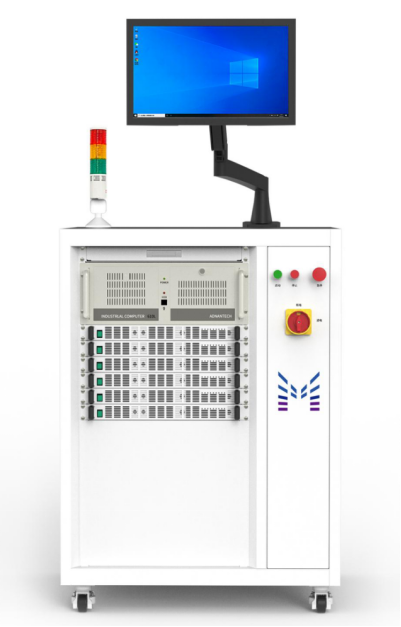
量子效率测试仪
PL/EL一体机
Sinton硅片少子寿命测试仪
Sinton硅块少子寿命测试仪
绒面反射率测试仪
3D共聚焦显微镜
清洗制绒工作站
在线四探针方阻测试仪
全自动扫描四探针方阻测试仪
在线薄膜厚度测试仪
晶化率测试仪
Horiba显微共焦拉曼光谱仪
傅里叶红外光谱仪
霍尔效应测试仪
分光光度计
全光谱椭偏仪
Horiba椭圆偏振光谱仪
TLM接触电阻率测试仪
超景深显微镜
网版智能影像测量仪
全自动影像测量仪
卧式拉力机
电池片稳态光衰老化试验箱
电池片紫外老化试验箱
电池片拉脱力综合测试仪
外观检验台
湿漏电测试系统
组件实验室EL测试仪
紫外老化试验箱
稳态光衰老化试验箱
电流连续性监测系统
PID测试系统
旁路二极管测试系统
LeTID测试系统
反向电流过载系统
脉冲电压测试系统
绝缘耐压测试仪
接地连续性测试仪
绝缘耐压接地测试仪
湿热环境试验箱
湿冻环境试验箱
热循环试验箱
动态机械载荷测试机
静态机械载荷测试机
冰雹冲击试验机
引出端强度试验机
霰弹冲击试验机
抗划伤(切割)测试机
剥离试验机
万能材料试验机(单臂)
万能材料试验机(双臂)
光伏玻璃透过率测试仪
醋酸测试试验箱
交联度测试系统
二极管接线盒综合测试仪
落球冲击试验机
半自动四探针
全自动探针式台阶仪
多通道太阳能MPPT系统
Horiba稳瞬态荧光光谱仪
钙钛矿P1激光划线测试仪
钙钛矿在线膜厚测试仪
钙钛矿工艺检测工作站
手持式IV测试仪
便携式EL测试仪
手持热成像测试仪
户外组件IV测试仪
户外组件多通道测试系统
光伏逆变器电能质量测试仪
无人机EL检测仪
钙钛矿/晶硅叠层太阳能电池稳定性测试
日期:2024-07-25浏览量:5
近几年来,钙钛矿/晶硅叠层太阳能电池凭借其宽光谱吸收、易突破Shockley-Queisser效率极限的优势而成为研究热点。但钙钛矿材料的长期稳定性仍然是一个重大挑战。钙钛矿材料对环境条件(如湿度、氧气和光照)非常敏感,容易发生降解。这会导致电池效率的快速下降,影响其实际应用。针对这一测试需求,「美能高温高湿环境试验箱」可模拟高温、高湿,长期湿气渗透环境,搭配「美能潜在电势诱导衰减测试仪」,评估电池、组件发生PID衰减后的电性能是否符合标准,帮助用户在提升电池、组件效率提供了有力支持。

钙钛矿/晶硅叠层太阳能电池发展形势
近几年来,钙钛矿/晶硅叠层太阳能电池商业化制造进程取得了前所未有的发展,其重要优势之一,就是可以跟高度成熟的商业化晶硅电池生产线进行集成制造。叠层电池由多个带隙不同的子电池堆叠而成,宽带隙顶电池与窄带隙底电池分别吸收短波长与长波长的太阳光,能有效扩宽太阳能光谱利用范围,提高太阳能电池光电转换效率。
表.最新钙钛矿/晶硅叠层太阳能电池2T、4T串联结构效率记录

*以上数据部分来源于NREL和马丁格林太阳能电池效率表(第64版)
尽管2T、4T串联结构显示了超高的能量转换效率,但是由于钙钛矿(PVK)材料本身固有的化学性质和器件结构,导致其稳定性往往不如晶硅电池。
钙钛矿(PVK)稳定性的外部影响因素
随着水分、氧气和光等环境因素的影响,钙钛矿材料的外部不稳定性会对钙钛矿/晶硅叠层太阳能电池产生负面效率影响。

钙钛矿/晶硅叠层电池外部不稳定性的主要诱因和钙钛矿电池的降解机制
在实际的可靠性测试中发现,钙钛矿PVK的晶体结构对温度、湿度和紫外线都保持高度敏感,这主要是由于不稳定的有机阳离子的存在以及水、光和氧气等外界因素引起的钙钛矿PVK材料的降解。
水分作为一种外在影响因素,一直被认为是影响钙钛矿稳定性的最有害因素。钙钛矿的制备通常在惰性气体保护的手套箱中进行,因为空气中的水氧分子可以会加速钙钛矿材料的降解。同时,由于钙钛矿材料的离子特性,其可以相对容易地溶解在水等极性溶剂中。所以,钙钛矿材料有明显的湿度不稳定性。湿度不稳定性可以通过封装有效解决。然而,在钙钛矿/晶硅叠层太阳能电池和组件制造过程中也会受到湿度的影响。
由于钙钛矿中的有机物质,例如PVK吸收层中的A位阳离子和有机电荷转移材料(spiro-OMeTAD、PCBM 和 PEDOT:PSS)的降解,PSC的性能在高温下会下降。因此,PVK 中的缺陷、界面特性和封装技术都会影响 PSC 的热稳定性。在实际户外应用过程中,要求太阳能电池可以在60℃以上的温度下持续工作,因此钙钛矿/晶硅叠层太阳能电池中钙钛矿材料的热稳定性对电池的长期稳定性至关重要。
所以,在钙钛矿/晶硅叠层太阳能电池商业化进场被迅速推动发展的过程中,需要着重关注产品的稳定性测试,以验证是否满足商业化应用标准。
并且对于钙钛矿/晶硅叠层太阳能电池而言,同时考虑晶硅子电池和钙钛矿子电池的不同退化机制和环境敏感因素是非常重要的,这就意味着,在实施可靠性测试的同时必须谨慎选择合适的老化策略以充分研判电池的退化情况。
钙钛矿/晶硅叠层太阳能电池稳定性测试
截止今天,关于单结钙钛矿电池的不稳定性测试已经有了大量的研究,但对于钙钛矿串联电池的相关测试仍旧很少,并且通常只关注时间、温度、湿度等部分外界影响因素,对于更深层次的,如湿热、紫外光、电势诱导衰减(PID)和机械载荷等实际测试场景的相关研究仍旧缺少关注。
以晶硅太阳能电池的光伏器件可靠性测试标准(IEC61215标准和IEC61730标准)为例,分别从组件应用安全和使用寿命的角度出发,列出了测试手段以及测试组合序列,是所有可靠性测试中最为重要的两类标准。
结合两项标准以及上述钙钛矿(PVK)稳定性的外部影响因素,可以预计,在针对钙钛矿/晶硅叠层太阳能电池稳定性测试中,湿-热试验和紫外耐久试验是必不可少的测试环节。
在这两项测试中,电池的电极将会产生电势诱导衰减效应(Potential Induced Degradation,PID),并且由于叠层电池的串联特性,器件的开路电压通常接近钙钛矿电池和晶硅电池的开路电压之和,这会导致更加严重的PID效应。所以了解叠层电池的PID作用机制和衰减效应也是重点研究方向。
美能高温高湿环境试验箱

联系电话:400 008 6690
光伏组件应用过程中会经受各种严酷天气的考验。其中组件承受高温、高湿,长期湿气渗透的能力等各项性能需要评估。为模拟高温高湿环境试验,验证评估组件或材料的可靠性,「美能高温高湿环境试验箱」ME-PV-DH9500由此诞生。
● 在(85±2)℃和(85±5)%RH的状态下持续运行1000个小时的超高的运行稳定性
● 内置循环风道以及长轴通风机,进行有效的热交换,环境箱内部温度均匀稳定
● 采用进口温度控制器,实现多段温度编程,精度高,可靠性好
● 可依据工程人员的计划进行高低温交互试验
● 可搭配潜在电势诱导衰减测试仪,可更直观观测组件的性能
美能潜在电势诱导衰减测试仪

联系电话:400 008 6690
「美能潜在电势诱导衰减测试仪」可与环境箱通讯,通过模拟实验电池片、组件长期在恶劣环境(高温、高湿、高盐碱)下发生PID衰减后来评估组件的电性能是否能符合要求。
● 采用研华优质的工控机,保证设备长期稳定工作
● 高精度正反向切换直流电源
● 实时监控电压,泄漏电流,绝缘电阻曲线
对于钙钛矿/晶硅叠层太阳能电池而言,钙钛矿材料的稳定性是限制其工作寿命的重要因素,也是阻碍商业化进程的影响因素。为完善和细化稳定性测量标准和流程,需要行业共同努力研究的目标,为提升太阳能电池效率指明方向。




































































